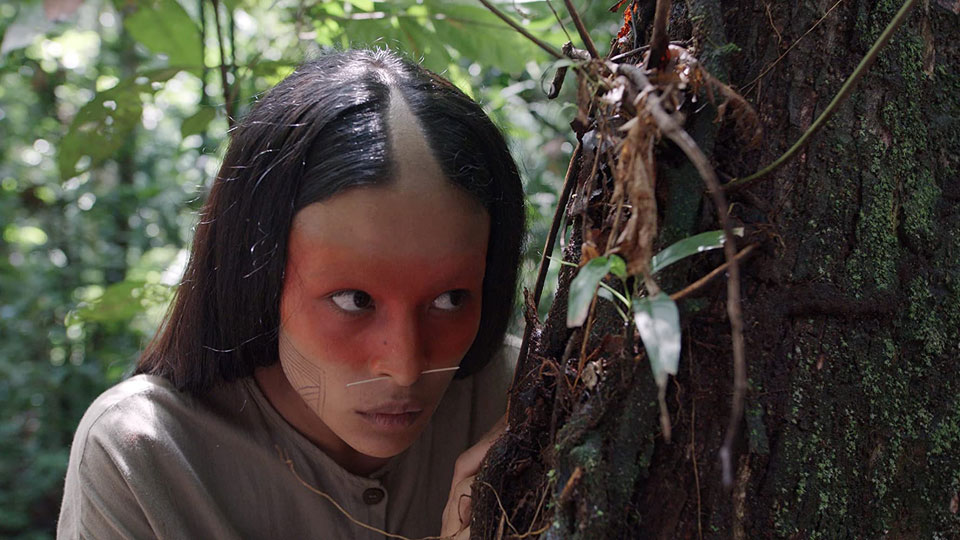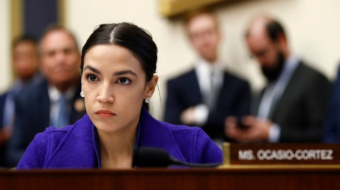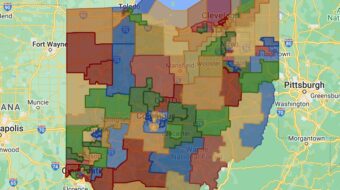
Two series from Colombia, Green Frontier and Wild District, both Netflix originals and both done by the same production house, Dynamo, stake out the left and right of Colombian politics.
The iconography of the progressive series, Green Frontier, links it with a history of Latin American films dealing with the continent’s Indigenous, a part of the tradition of Magical Realism which charts the imbrication of Indigenous ways in a colonized landscape. The series’s thematic centers on the destruction of the Amazon on the Colombian-Brazilian border and a “lost,” i.e., heretofore unknown tribe trying to ward off the loggers who would destroy them and the forest, along with the deeper, more insidious and more persistent menace of Western colonialism.
Wild District, on the other hand, employs the iconography of the American action film in its more regressive and caricatural depiction of guerrilla forces as savages and its racist and classist characterization of the slums of Bogotá as just another jungle, as primitive and untamable as the actual jungle inhabited by the rebel group the FARC, rather than the habitat of one of the continent’s poorest and most deprived populations.
Since both series are Netflix originals, it would seem the streaming service is interested in covering all bases, that is, attracting with the more independent and more off-kilter Green Frontier, whose pilot is directed by the superb Ciro Guerra, a progressive audience committed to the ecology of preserving the rain forest and the country’s Indigenous. With the straightforward action series, which boasts a superb performance by Narcos veteran Juan Pablo Raba, the service seems to be appealing to the populist and far right in a show that openly rationalizes the work of the death squads, an auxiliary of the former Uribe government.
The pilot of Green Frontier is directed by Guerra and the series owes much to both his visual acuity and his thematic concerns. His first global success, the film Embrace of the Serpent, tracked the relationship between two aging members of their respective civilizations, a German social scientist in the jungle at the turn of the last century in the vanguard of what would be a pillaging and patenting of its secrets for what would become Big Pharma, and his guide, an Indigenous last member of a tribe wiped out by the European colonizers. The Indigenous guide recalled this devastation in a series of scattered images that operated more from an intuitive and unconscious logic than the Western scientist’s rational mapping of this world. In Green Frontier, a warrior, one of the last members of his tribe, communicates with a female member both in this world and an otherworldly sphere with the otherworldly images in a negative silvery tint.

Guerra’s second film, Birds of Passage, adopts codes from the gangster film to recount how an Amazon tribe succumbs to the profit motive inducement of the drug trade and how the ensuing greed for material objects utterly demolishes their centuries-old customs and ways of life. It’s The Godfather or Scorsese’s Casino in the jungle as it maps the changes wrought by money. It is even closer to Gangs of Wasseypur, a stunning Indian film about the changes wrought in an Indian province over 40 years by the introduction of a profit-making gangster economy.
Green Frontier, likewise, presents the jungle under attack from the loggers who are stripping its assets, from a mysterious white man who is a demon with a history that extends back to the Nazis, and from the local corrupt police whose leader, “Uribe,” orders the killing of the Bogotá female agent who instinctively acts to protect the jungle.
The series opens in the present with the slaughter of both an Indigenous woman Ushe and a group of nuns, and is an investigation into the killings by the Bogotá agent Helena and her partner Reynaldo, who has been outcast from his Indigenous community. A flashback narrative recounts the relationship of Ushe and Yua, the male protector of the jungle. The jungle itself is defined as both holder of the secret of life and as female.
The flashbacks are not so much backstory, as they would be in a more Euro-centered narrative, as they are a parallel world with the jungle itself acting to protect Yua and at times make him invisible. The series is elegantly filmed on the Colombian-Brazilian border, and the loggers, whose boisterous chainsaw at one point interrupts a conversation between Ushe and Yua, are the visual and aural sign of the Bolsonaro-Trump assault on the environment, waged in the Brazilian case against the rainforest and in Trump’s case against public lands which he is now opening to drilling and mining.
The series ends with an epic battle between Helena, now in touch with her roots in the earth and allied with the jungle, and the white demon Joseph, a remnant of the Nazis, that is, of the ultimate degradation of Western civilization. It’s a monumental struggle and one those who want to save the earth are engaged in each day.
Wild District, on the other hand, is far-right nonsense that misses completely the changes that are going on in Colombia, a traditional bastion of Latin American conservatism and U.S. ally which is in the process of attempting to get out from under the thumb of its history of violence and right-wing death squads. The recent home-arrest of the hit-squad-aligned former president Alfaro Uribe for corruption is a sign of these changes.
The question in Colombia at the moment is the question of peace, as the FARC, the revolutionary guerrillas, have been more than willing to lay down their arms and accept a peace deal in order to challenge the right wing at the polls as a political party. However, despite overwhelming popular support for the peace process, the current president Ivan Duque, a protégé of Uribe, opposes it and allows the guerrillas to be assassinated by still highly active right-wing killers as the former guerrillas, having surrendered their weapons, are now defenseless.

None of this is even hinted at in Wild District, which is rather than a television series, more a sounding board and rationale for far-right sentiment and continued slaughter in the country. The FARC are portrayed as bloodthirsty kidnappers of children, ignoring any rooted connection they have with the peasantry, as simply sadistic killers, with no mention of the far-right death squads who hunt them, and as grudge-bearing executioners of those who would desert them, forgetting that the FARC as a unit has pushed for peaceful disarmament.
The series is so far right it would have difficulty even finding a place on the Fox Network, though it might fit comfortably in an evening slot on the Fox News Network between discredited Fox commentators Bill O’Reilly and Megan Kelly. This series makes Jack Webb, the McCarthyite-era creator of Dragnet, look like Bernie Sanders. It lacks the subtlety of even a 24 or a Homeland, where at least the ideological message is complexified and subtly obscured.

Its redeeming feature is the lead character, Jhon Jeiver, a “light foot” FARC former assassin who creeps up on everyone but whose effort to insert himself into everyday life is touching and includes his attempt to reestablish a relationship with his son. In a well-drawn scene in the market where he has found work, Jhon tells a female customer seeking a solution for a burn to forget a pharmaceutical remedy and instead shows her how to apply the healing plants aloe and calendula (marigold) that he learned in the jungle. His nemesis on the series is of course the sniveling sadistic jungle revolutionary who wants to continue the fighting, the exact opposite of the contemporary Colombian reality.
The difference in the two series is strikingly apparent in the use of the names of the Colombian leaders. In the far-right Wild District, “Duque,” the current leader now accused in the press of corruption who opposes the peace process, is the name of the tough on the outside but heart-of-gold female detective who is Jhon’s handler. In Green Frontier, “Uribe” is the corrupt head of the local police who orders the assassination of Helena, the eventual protector of the jungle and of the authentic Latin American heritage.
The ideological difference between the two series is shocking, but of course one way of conceptualizing it is to say that although this is the left and right, it is a left and right both under the banner of and contributing to the profit of Netflix, the global entity.
However, there is still a stark contrast between two views of Latin America. Green Frontier is allied with the Bolivarian Revolution which attempts to redistribute wealth and raise the living standard of the continent’s poorest, often those with an Indigenous or African background. Wild District aligns itself with the Bolsonarian Revolution which attempts to sell off both the natural and cultural heritage of the continent in its return of wealth back to the richest. One revolution attempts, as does Helena, to preserve the continent. The other, which like Wild District characterizes all efforts at change as savage, instead, as can be seen in the murderous spread of the Coronavirus out from Brazil to its neighbors, attempts to destroy the continent and keep it under the colonial heel.












Comments